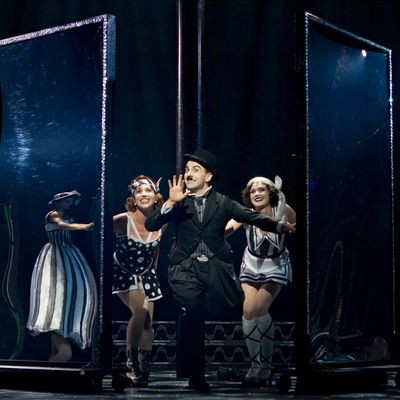
Chaplin, the schematic new biomusical from composer-librettist Christopher Curtis, co-book writer Thomas Meehan, and director-choreographer Warren Carlyle (Finian’s Rainbow), is remarkable for only two reasons — and two, in this show’s case, is enough. The first is its leading man, Rob McClure, a relative-unknown who won’t be for much longer. And the second is its aggressive and almost insulting simplicity. In form, structure, and substance, Chaplin is a kind of Wikimusical, earnest and on-the-nose and exhaustively idiot-proofed. This ought to make it a massive bore — and indeed, its black-and-white Hollywoodland palette and bildungs-by-numbers approach to character occasionally come just short of silliness. Chaplin is a musical built from a kit — tab A always fits snugly in slot B — but it is a sincere and committed one, and, thanks to Carlyle’s lightfooted staging, its before-your-eyes construction of itself never feels laborious. Charlie Chaplin’s improbably epic rise and fall makes a good story, and the playmakers do nothing to get in the way of that (or, more importantly, of McClure). And the pleasant pastiche-quiche of Curtis’s score functions as a sort of airplane glue, holding everything together not unlike effectively manipulative film music — it even manages a few corky motifs along the way. This is, in many ways, your father’s or even your grandfather’s musical, in temperament if not in sheer inspiration.
McClure is the mainspring in this not-quite-modern apparatus; so dominant is he that it can be difficult to see (or care about) the surrounding flywheels and driveshafts. First having bounded into the limelight with a shimmering title turn in the Encores! revival of Where’s Charley?, McClure once again proves himself a brilliantly gifted physical comedian, an able clown, and a passionate musical-theater performer, all rolled into one. Playing any icon is a terrifying risk; playing Chaplin, the world’s first international film star and one of the most versatile entertainers in history, is practically a suicide pact. McClure’s Chaplin — especially when not in Little Tramp mufti — is a vastly different being from the great, glowering depressive created by Robert Downey Jr. Much is made of Charlie’s childhood in this show, and McClure finds Chaplin’s highs and lows in his child-self: At his heights, he finds genius in pure play; in his depths, he is a champion thrower of tantrums. And always, always, he is in motion: Even McClure’s stillnesses are electrified with semaphore.
As the book dutifully footnotes history and spells out What Comes Next — Charlie’s rapid ascent from English music-hall urchin to dawn-of-celluloid contract player to superstar actor-director-producer-composer, studio-owner, and, eventually, political firebrand — McClure is telling a far more interesting story with his body. He’s not as wiry as Chaplin, but his limbs have the same elastic quality, and he produces the same visual illusion of an adorable everyclown with no unforgiving angles, no pointy perpendiculars — at least not when the cameras are rolling. Off stage, he can be imperious, self-righteous, and not-so-faintly messianic: The internationalist funhouse-mirror-image of his unlikely twin, Adolf Hitler, who will be the subject of his greatest and most controversial comedy, The Great Dictator. (And then, of course, there’s his notorious penchant for very young girls — which Chaplin, no surprise, treats with a great deal of indulgence.) The show, true to pop-biography convention, organizes everything around Charlie’s troubled relationship with his mentally ill mother Hannah (Christiane Noll), who teaches him his formative lessons in showbiz and in loss. “Look at all the people,” she sings, “and see into their eyes / Try to find the story / Behind each one’s disguise.” That’s a hammeringly basic lyric, and when it recurred in flashback, I broke out in a fear-sweat. But once Carlyle and McClure have executed a buoyant costume-closet ballet atop it—as Charlie assembles the Tramp out of shreds and patches and delicately magpied humanism—we barely care. We’re in.
Chaplin seems to be dragging some ghostly vestiges of its road self. (Under another title, Limelight, it underwhelmed at La Jolla Playhouse.) The first act relies heavily on a creaky film conceit. (We’re supposed to be on a bare soundstage, watching Chaplin’s film of his own life — though the only meaningful sign of this is a recurring slate boy, calling out scene changes.) This frame feels entirely unnecessary; worse, it means the actors have to wear unevenly applied “silent-film” greasepaint. (Some look entirely untouched; others are zombified outright. It’s strange, distracting, and superfluous.) The best moments are those uncrowded by book-prattle and empty business, where McClure owns the spotlight. His Chaplin is a pen-and-ink drawing composed of basic shapes and Hirschfeld-curvy simple lines, but once his character is in play, it never stops moving, and we waddle right along with it. As a musical, Chaplin is squarely in the middle of the middle of the pack; as the canny redeployment of an icon, it sometimes flirts with excellence.
Chaplin: The Musical is playing at the Ethel Barrymore Theatre.




